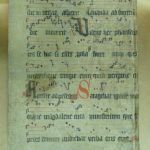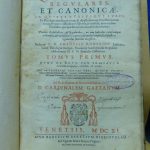The endpaper of the host volume names the Franciscan convent of Zagreb as the possessor, the stamp also confirms that. The Matins of the Mary Magdalene office (22nd of July) is legible on the verso of the undetached bifolio’s first leaf. Great variability is characteristic of the Mary Magdalene office’s composition, it is possible to record variants within the same tradition.
There are 8 lines with text and music on the top and on the side cropped bifolio. On the first leaf, the entire written width is visible, since the end of the lines are at the spine of the book. The first identifiable chant on the fragment is the Hanc vero quam Lucas responsory, the beginning of the chant is lost. It is recorded by the CANTUS database in a well-outlined Central-European circle of sources with South-German, Polish, Bohemian and Hungarian finds (A-KN 1012, A-KN 589, PL-KIk 1, D-FUl Aa 55, GB-Ob Laud Misc. 284, TR-Itks 42, see https://cantus.uwaterloo.ca/search?t=Hanc+vero+quam). The beginning of the verse is also visible: the usual Videns haec Phariseus is attached to the main part of the responsory. An incipit with musical notation indicates the next responsory – Accessit ad pedes – presumedly because it appeared in the parent codex earlier, as the responsorium prolixum of the first Vespers (it was also used like this in the Esztergom tradition). This presumed “use in advance” helps in the determination of liturgical position, since mostly the last responsory of the Matins was prescribed in the Vespers, or rather, the responsory of the Vespers (or multiple Vespers) was written as the last (sometimes extra) responsory of the Matins. The fragment in question, however, shows a more irregular solution. The next chant is the Satagebat igitur Martha soror antiphon. Despite being quite variable, the Lauds of the Mary Magdalene office never starts with this chant. We cannot assume anything, but it being a Matins antiphon, and in this case, we are at an earlier point of the office: instead of the end of the entire Matins, only at the end of the second nocturn, at the first antiphon of the third nocturn, even if it seems quite odd, that the sixth responsory is used in the Vespers. The Stagebat does not appear in the inner circles of the Esztergom tradition, which gives another set of chants after the invitatory Ploremus coram Domino [N1 a1 Rogabat Iesum quidam etc. (cf. Andrea Kovács ed., Corpus Antiphonalium Officii Ecclesiarum Centralis Europae V/B Esztergom (Strigonium), Budapest, HAS Institute for Musicology, 2006, 114)].
The chant selection of the fragment appears as an individual variant on three breviaries supposedly from Szepes county (Alba Iulia, Bibliotheca Batthyanaeum, R. II. 46, R. II. 94; Budapest, Hungarian National Museum, 63.74.I.C): these sources also prescribe the Stagebat, which is missing from the Esztergom tradition. Among the sources of the Hungarian rite variants, the Stagebat appears in the Matins of the Zagreb rite (and also as the Lauds’ third antiphon in Transylvania), not to say, that in a certain circle of 14th–15th-century Kalocsa-Zagreb breviaries (Zagreb: HR-Za I.c. 42, HR-Zmk MR 104, Kalocsa: H-Bn Clmae 33, HR-Zmk MR 43, I-Rvat Ottob. Lat. 667) the chant selection and arrangement is precisely in range with the office part preserved on the fragment. (see Andrea Kovács ed., Corpus Antiphonalium Officii Ecclesiarum Centralis Europae VI/B Kalocsa-Zagreb, Budapest, HAS Institute for Musicology, 2008, 108). The solution of the fragment turns our attention on one hand to the malleable chant selection of the Mary Magdalene office and its divided nature within a given tradition, and on the other to the subtraditions, and – based on the fragment’s current location – to Zagreb.
On the other leaf of the bifolium (assumedly on the recto) parts of the office of Inventio Stephani (3rd of August) are visible. The written width is incomplete. The historia Luciano venerabili is the work of Stephan von Lüttich, it can be detected consistently in the Kalocsa-Zagreb rite within the Hungarian tradition as early as the 13th-century Zagreb breviary (Zagreb, Metropolitanska Knjižnica, MR 67). However, only later sources document it in Esztergom. (For the data from Kalocsa and Zagreb see Andrea Kovács, CAO-ECE VI/B Kalocsa-Zagreb, 73). It can be found in every 15th-century Esztergom breviary except for two sources (Vienna, ÖNB, Vindob. Pal. 1481; New York, Pierpont Morgan Library, MAG. 7), cf. Andre Kovács, CAO-ECE V/B Esztergom (Strigonium), 73). The antiphon Luciano venerabili starts with a red capital letter, like Stagebat before, indicating the chant’s genre and position: both are the first piece of a series of Matins antiphons. The second and third antiphon follows each other in the usual order: Dum adhuc paene, Vidit igitur assistere, as well as a part of the matins’ first responsory Beatus Gamaliel in the last, incomplete line of the fragment. This series of chants is in line with the widespread composition, only the feast’s stable position brings us closer to Zagreb as the place of origin.
The music of the fragment is written with an articulated, traditional notation rooted in the notation of medieval Esztergom. We can sense both the cursive Esztergom notation, which was fashionable after the second half of the 14th century and showed the influence of the Gothic pen technique. The traditional conjunct structures are falling to pieces (e.g. pes, torculus, porrectus). However, a few unique detail catch one’s eye compared to the late articulated Esztergom notation. In the scandicus the stroke marking the middle note, or the stem of the pes usually leans to the left, which gives a special character to the overall look of the notation: it is unusual, as is were, local touch. The other talebearer neume is the clivis: albeit being archaically conjunct, it is not the usual right-angled form, the upper element lies on the staff at an angle, namely, it makes a bigger angle with the lower element. In the case of a smaller step the angular “hat” is elongated, however, in the case of a fourth or a fifth, it is quite shortened. The unique shape of the clivis can be understood as a trace of a local practice further away from the main Esztergom tradition. The flexible starting and finishing lines are worth the attention, they give a peculiar roundness to the clivis for example. The closure of the sign is not settled yet, in some cases instead of the light, hair-thin finishing line a z-shape is visible with stark, thick and elongated neume ending. Contrary to the Esztergom tradition the climacus and its compound neumes always start from an individual punctum, and the line of dots is slanted. Due to the size of the notes, this writing direction is not unusual in the 15th century, moreover, it is a general attribute of the Gothic Esztergom mixed notations. At the same time, the combined presence of the three signs (direction of stem, angle of clivis, structure and direction of climacus) gives a notable starting ground for the identification of similar fragments.
We can assume a parent codex originating in the Zagreb rite based on the host volume’s location, the liturgical content analysis, and the mature musical notation with individual characteristics (refer to the analysis of the mother codex’s other fragment – F 1106).
Gabriella Gilányi




